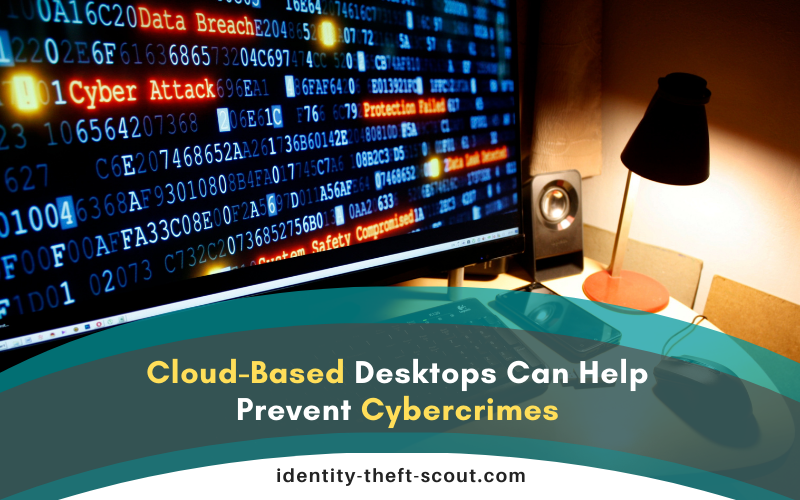
We are on the edge of The Fourth Industrial Revolution and digital transformation. It is an era where technology progresses quickly, but so do cyber crimes. Recent data, including responses from different countries, disclosed the rise in cybercrime ever since the pandemic. During COVID-19, phishing, fraud, and scam attacks increased by 59%, and ransomware or malware attacks increased by 36%. However, businesses can protect their sensitive data by using cloud desktops or DaaS. This post will focus on how cloud-based desktops prevent cybercrimes.
How Cloud-Based Desktops Can Help Prevent Cybercrimes
Despite the high damage associated with cybercrimes, businesses are still not prepared to fully address these risks. Did you know that the Equifax breach robbed the company? of USD 4 billion? The market value of the company instantly decreased, and their loyal customers shifted to other providers.
Are you ready to face such risks? If your security structure requires substantial support, cloud hosted desktops can assist you. This is how:
1. Using Thin Clients For Desktop Access
To understand how thin clients are used to ensuring security from cybercrimes, let’s understand how cloud desktops work:
Typically, when we work in the office or at home, we use hardware units, such as laptops, desktops, and PCs, to tap into the company’s resources. These are tangible resources that can be attacked and destroyed by a virus.
However, cloud desktops use remote server hosting. Your Cloud Service Provider (CSP) hosts the resources on a cloud server and creates multiple virtual desktops. You can easily access these desktops using thin clients and make your business operations more secure.
For example, if the user loses the thin client, no one can access your company data without login credentials. Also, thin clients do not store any data (unless saved manually) or cache files into the hard drive and just act as a medium between the users and the data.
2. 256-Bit Data Encryption for Security
On the cloud, data is encrypted before transmission. Many CSPs use 256-bit encryption along with TLS 1.3 to secure your data. So, when sending data files to and fro from the cloud desktop, it is end-to-end encrypted for secure transmission.
To further allow strong security of stored data, providers also use encryption on the resting data. This means even when an intruder finds a route to your desktop, your data is encrypted.
3. Ransomware and DDoS Security Monitoring
DDoS and ransomware attacks are damaging and extremely challenging for any business. In case of a ransomware attack, there’s no choice other than to offer the ransom while still risking a data breach.
Reputed DaaS providers use safeguards like Intrusion Detection and Prevention systems, IP restrictions, DDoS control, and other cybersecurity measures.
These security implementations continuously monitor your desktops for any unusual activity. So, if required, IPS/IDS and other systems automatically eliminate most of the threats.
4. End-to-End 24/7 System Monitoring
In every cloud desktop system, there is a risk of unwanted traffic and hacking activities. To avoid these attacks from happening, CSPs consistently monitor cloud desktops. Apart from using the above automated controls to prevent intrusion, there are manual efforts for checking unusual activities.
The team of the cloud provider audits the entire infrastructure of cloud desktops to avoid intrusion, unwanted traffic, and virus attacks on the data and applications.
5. IT and Security Experts Offering Support
The cloud is managed by IT experts who understand security closely. This understands security architecture, loopholes, and concerns regularly. They find security loopholes and upgrade patches, ensure proper use of new security implementations, and address intrusions quickly. Your CSP can offer enterprise-grade security!
6. Ensuring Data Recovery
In this digital age, data is of utmost importance for businesses. However, disasters are unpredictable and can occur anytime. This means that any hardware, even your hard disks, can get damaged easily, and you may lose your data permanently.
If you use cloud-based desktops, service providers create multiple copies of your data on multiple servers located in different regions. So, in case of any disaster, you do not lose your valuable data. For instance, if your workplace is hit by a ransomware attack,
you can retrieve your data quickly from any other server and do not need to pay the ransom.
Other Benefits of Cloud Desktops That Enhance Security
Cloud desktops are cost-effective. There are no migration costs and recurring hardware costs. When implementing the cloud, you can ensure secure operations as per your budget.
Security experts of the CSP are working round-the-clock. Your IT team doesn’t need to spend time ensuring security or achieving other admin tasks.
Cloud desktops provide BYOD and remote working feasibility securely. Allowing secure remote access to office apps is challenging but necessary. The cloud makes your task easier.
Prevent Cybercrimes: Use Cloud Desktops
Businesses are interested in improving the security structure of their workplace. Cloud desktops are equipped to reduce risks, prevent cybercrimes, and offer secure data access. Simply understand the security benefits of DaaS and use this implementation to overcome cyber threats, such as scams, ransomware, etc.
Author Bio: Bhavleen Kaur is a content writer at Ace Cloud Hosting- a leading Desktop-as-a-Service (DaaS) solution provider. She specializes in writing about VDI, DaaS, cloud technology, cloud-based desktop & likes to know about upcoming technology and trends. In her free time, you can find her reading novels or watching movies.















